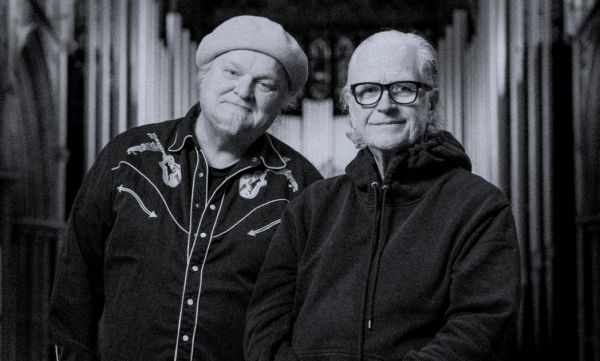

Iver Kleive & Knut Reiersrud
Knut Reiersrud’s work and many collaborations have ranged widely across blues and the folk music of Norway, Africa and beyond, and organist Iver Kleive has been a long-time musical partner in some of them, including in the mighty theme of the 1994 Lillehammer Winter Olympics. Their earlier duo albums were recorded in Danish churches with a suitable combination of organ and acoustics, but this time they’re in an even more appropriate place, the 800-year-old Nidarosdomen Cathedral in Norway’s Trondheim, built over the grave of Olav Haraldsson - Olav the Holy, who died in 1030. Olav came there from Kyiv, once a Viking capital whose Norse name was “Kønugard,” and that’s the name of the opening track, a composition by the duo reflecting in its calm hushedness the fact that these recordings were made in the cathedral’s quietest time, overnight from 11pm to 6am. Behind the softly limpid electric guitar the organ moves gradually to a mid-piece swell, just a hint of what's to come later in the album, before returning to quiet accompaniment. Track two, “Hellig Olav,” similarly serene, is based on a piece by early 20thC organist Gottfred Pedersen. “Ljoset over landet dagna” moves between a bubbling effected guitar pattern and sustained guitar and organ playing the stately melody. It draws on one of the medieval melodies from Olavsmusikken, a celebration of Olav particularly associated with Nidarosdomen. The German traditional “Vidunderligst av alt på jord” (‘The most wonderful thing on Earth’) features pattering guitar harmonics and a winding solo line against the organ’s shifting drones.
It’s in the treatment of “Dies irae,” whose plainchant melody dates from about the 13th century, that the organ gets wild, with across-keyboard slathers over an ominous pulse, growing to the dizzying jumble of notes that a church organ can do when a series of chords and overlapping ripples of notes and dissonances are played into the church’s reverberation. It dies away to a growl, then slithering, soaring spacey sounds (Kleive is credited on this track with ‘processing’) catapult across the stereo, subduing to echoing moans and ending in a quiet, simple line.
“Dype, stille, sterke, milde” opens with oud, extemporizing in an almost ‘Concierto de Aranjuez’ mode over calm quiet organ that takes over, joined by the oud re-stating the melodic theme, alternating with what is perhaps one of the organ’s reed stops. Deep, quiet, strong and gentle, as says the title of the piece, which uses a melody from 19th-century Norwegian organist-composer and folk-song collector Ludvig Mathias Lindeman.
Washes of phased and deep-reverbed guitar introduce the stately “Apostlenes hester,” which sounds like it must be a traditional hymn but is a fine, memorable Reiersrud/Kleive composition, perfect for a film theme. “Jeg ser deg, O Guds lam” is indeed a traditional Norwegian folk tune, in which the soaring guitar notes slide in without attack, song-like. Low echoed guitar notes and the organ’s higher register begin “Til Ungdommen,” by 20th century Danish composer organist Otto Mortensen.
A hymn tune that many outside Norway might recognize, by Charles Wesley’s grandson Samuel Sebastian Wesley, is stated on guitar in “Guds kirkes grunnvoll ene” then morphs into the only vocal on the album, Reiersrud showing his roots in American musics by singing the spiritual “she’s got the whole world in his hands.” In “Som den gyldne sol frembryter,” based on a hymn tune by 17th-century German composer Johann Schop, the organ plays a chunky chordal 4/4 intro and coda with, between them, an almost vocal sustained guitar over full-on organ. Reiersrud’s “Hvorom alting er” is a velvety, serene album closer. As well as this most recent album, I’d recommend a listen to the duo’s earlier works, which began with 1991’s Blå Koral, and particularly their mighty composition for the Winter Olympics, “Nåde,” with Marilyn Mazur’s percussion thundering in the cathedral vastness (it also appears on their album Nåde over Nåde), as well as Kleive’s Kyrie and Reiersrud’s various and varied other albums, a favorite of those being the splendid culture-crossing Tramp (in the US retitled and not quite so satisfyingly re-sequenced as Footwork) that features Iver Kleive, the Five Blind Boys of Alabama, Alagi M’Bye, Juldeh Camara, Amadou Sarr, Audun Erlien and Paolo Vinaccia.
Search RootsWorld
|